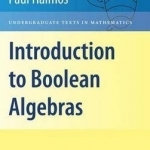Introduction to Boolean Algebras
BookThis item doesn’t have any media yet
2008 | Science & Mathematics
The theory of Boolean algebras was created in 1847 by the English mat- matician George Boole. He conceived it as a calculus (or arithmetic) suitable for a mathematical analysis of logic. The form of his calculus was rather di?erent from the modern version, which came into being during the - riod 1864-1895 through the contributions of William Stanley Jevons, Aug- tus De Morgan, Charles Sanders Peirce, and Ernst Schr. oder. A foundation of the calculus as an abstract algebraic discipline, axiomatized by a set of equations, and admitting many di?erent interpretations, was carried out by Edward Huntington in 1904. Only with the work of Marshall Stone and Alfred Tarski in the 1930s, however, did Boolean algebra free itself completely from the bonds of logic and become a modern mathematical discipline, with deep theorems and - portantconnections toseveral otherbranchesofmathematics, includingal- bra,analysis, logic, measuretheory, probability andstatistics, settheory, and topology. For instance, in logic, beyond its close connection to propositional logic, Boolean algebra has found applications in such diverse areas as the proof of the completeness theorem for ?rst-order logic, the proof of the Lo ' s conjecture for countable ?
rst-order theories categorical in power, and proofs of the independence of the axiom of choice and the continuum hypothesis ? in set theory. In analysis, Stone's discoveries of the Stone-Cech compac- ?cation and the Stone-Weierstrass approximation theorem were intimately connected to his study of Boolean algebras.
Related Items:
| Published by | Springer-Verlag New York Inc. |
| Edition | Unknown |
| ISBN | 9780387402932 |
| Language | N/A |
Images And Data Courtesy Of: Springer-Verlag New York Inc..
This content (including text, images, videos and other media) is published and used in accordance
with Fair Use.
